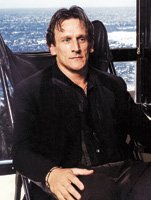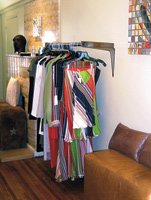The Philosophy of Peter Cohen
Subtle details, lush fabrics and a well-heeled clientele have kept Los Angeles–based Cohen designing locally for 20 years
Peter Cohen is getting a little philosophical.
“Clothes to me are things you have to operate,” Cohen said. “You have to drive them. It’s how you put it together, how you personalize it. It’s getting that pant and that shirt to connect.”
It was a sunny spring afternoon in Los Angeles, and the designer was on the patio in front of his Sycamore Avenue store. The Peter Cohen boutique is in a bungalow tucked behind florist shop and cafeacute; Rita Flora. To enter, you have to turn into the parking lot from a discrete alley and chat up the parking attendant, who will cheerfully help you find a spot in the small, crowded lot. It’s all very L.A.
Cohen, who has been quietly creating his high-end and subtly sophisticated designs in the city for 20 years, is also very L.A.—although you might not immediately come to that conclusion.
There’s still a bit of an accent tingeing the South African–born designer’s speech, and although he is blond, it’s natural. But he is just as likely to greet his customers in jeans and a stark white shirt as he is to don a bespoke suit. And he has a relaxed familiarity with the designers and key players in Los Angeles’ industry— even if he keeps a low profile.
It’s Cohen’s iconoclasm that marks his membership in Los Angeles’ design community. Cohen doesn’t follow trends; he opts to create timeless pieces that enhance rather than overpower the wearer.
“When I see a very well-dressed person, I don’t want to be overwhelmed,” he said. “The clothes have to be secondary. I think clothes are too much speaking for somebody— or attempting to. My customers want to talk for themselves. They don’t want to communicate entirely sartorially.”
It’s a philosophy that has earned him an illustrious clientele that includes celebrities Oprah Winfrey, Sharon Stone, Ann Magnuson, Angela Bassett, Faye Dunaway, Kim Cattrall and Lily Tomlin, as well as less well-known notables such as philanthropist Melinda Gates, wife of Microsoft Corp. founder Bill Gates. And it is a strategy that has allowed him to grow his designs into a $5 million apparel line manufactured entirely in Los Angeles.
Out of the spotlight
Cohen’s behind-the-scenes approach extends to the label sewn into his designs—no name, just a star. After a rather splashy beginning, the designer stepped out of the spotlight and ceded attention to his famous customers.
“I started with an enormous amount of exposure but no business,” he said. “In the last three years, I don’t have to explain what I do as much.”
The self-taught designer launched his line in 1983 after a brief stint in New York, where he worked for designer Peter Kea.
“Adventure took me to New York, and family brought me back,” explained Cohen, who divided his time growing up between South Africa and Los Angeles.
Cohen’s debut was well received, landing him floor space at Barneys New York and Wilkes Bashford in San Francisco and garnering editorial coverage in The New York Times, GQ and Vogue.
“I don’t know if I would have made it in New York,” said the designer in retrospect. “I wouldn’t have been allowed the time it took to succeed. Being in L.A. allowed me to work at my own pace.”
Cohen’s pace and design style may best be described as thoughtful. Each season, he faces the challenge of creating clothing that will stand the test of time. As an example, he describes an enduring classic: a Levi’s denim jacket.
“There’s nothing I like more than a garment that is ageless—it is genderless, it can be worn again and again—that takes on the design of everybody who wears it,” he said. “You could put it on 20 people, and it would look different on each of them.”
Cohen has a few timeless pieces—his greatest hits—that make their way back into his collections season after season.
“One of my most popular styles to this day is a style from my first collection,” he said, speaking of an open-collar simple tunic with a front placket that he has dubbed the “ethnic blouse.”
“It’s one of those pieces that embodies what it is I do,” he said.
Fabric-driven and locally made
Cohen takes his design cues from the fabrics he chooses and from the women who wear his clothing.
He sources his fabrics from Italy, France and Switzerland, opting to browse fabric showrooms in New York or scout for new resources at Premiegrave;re Vision in Paris.
“I’m a buyer of expensive fabrics,” Cohen said. “It’s one of my pleasures. I buy novelties from the French and the Swiss, and I buy base goods from Italy. The Italians know how to make the simplest thing, the finest stripe, in the most pure way. The French make lots of fabulous folly. But actually the real couture houses are Swiss.”
The entire collection is produced in Cohen’s Los Angeles headquarters, with each piece made individually by a team of 35 staff sewers under the direction of Production Manager Rudy Cervantes.
In all, Cohen employs 45 people at his Washington Boulevard design studio. The cost of in-house production is high, but it allows him to oversee the quality of his collection.
“I wouldn’t know how to do it any other way,” he said. “There are costs that could be avoided, but there are conveniences that make it worthwhile.”
The hands-on construction and the top-ofthe- line fabrics are reflected in the collection’s details and its prices. The Fall 2004 line includes bias-cut dresses, skirts and trousers in printed mousseline and silk chiffon, tailored cashmere separates, satin-backed crepe in moody shades of midnight and chocolate, and equally somber felted stretch wool in burgundy and chocolate. There’s also a bit of Los Angeles glam, including Lurex, sequins and lambskin. Wholesale prices range from $110 to $1,600.
Peter Cohen is carried in A’Marees in Newport Beach, Calif., Mario’s in Seattle and Portland, Ore., RTW in Charleston, S.C., and in 11 Saks Fifth Avenue stores in the retailer’s Gold Range Assortment, alongside labels such as Lida Baday, Rene Lazard and Zenobia Collections.
Michael Fink, senior fashion director for Saks Fifth Avenue, described the line as “easy, relaxed, lifestyle dressing” that appeals to a wide range of customers. Indeed, the collection sells best in Saks’ stores in New York, Beverly Hills and Palm Desert, Calif., according to Fink, who noted that Cohen’s customers tend to purchase complete ensembles from the collection.
“It’s head-to-toe dressing— she buys the whole outfit,” said Fink, who said the four-ply silk line ranges from a great-fitting pant that customers are “hooked on” to body-skimming bias-cut dresses, which are also strong sellers.
Cohen’s subdued color palette also helps the customer mix in new pieces that work back to items she already has.
“It’s black/white dressing, although each season he has an accent color,” said Fink, explaining, “It’s cumulative wardrobe building on what she already owns.”
On and off the runway
Many members of the Los Angeles design community got a chance to see Cohen’s work at the The Standard Downtown Los Angeles during Mercedes-Benz Shows L.A. last year, the first year that New York–based show producer 7th on Sixth hosted its West Coast event. On the runway, Cohen showed his Spring 2004 collection of buttery jerseys, lofty wools and liquid velvets, as well as pieces from his custom menswear line, including sherpa jackets, casual suiting separates, and shirts and tees in luxurious jersey and suede.
The designer opted not to join the lineup last season, although he dropped by the opening-night party at Saks Fifth Avenue to mix with the designers, show producers and press. Cohen does not rule out future fashion shows, but he is contemplating how to best show his subtle styles. “My clothes interact in a closer context—that’s where they come to life,” he said.
The designer participates in a regular round of trunk shows, including trips to Mario’s in the Pacific Northwest and the Saks stores in Palm Desert, Calif., Minneapolis, Charleston, Philadelphia and New York. He will add She-La in Omaha, Neb., to the lineup in August.
It is a whirlwind schedule for the low-key designer, who said he “didn’t naturally take to” the trunk show format.
“I’m not the kind of designer who says, ’Cut your hair, walk sideways, lean on your left leg.’ I’m not comfortable doing that,” he explained. “That said, I’m quite adept at it at this stage.”
Cohen said he is fortunate to have a loyal following for his designs, noting that some customers arrive at his trunk shows bringing a favorite Peter Cohen design from 10 years before.
“There’s a timeline with clothes and fashion,” he said. “For some reason, you don’t have to wait a decade for some of my styles to repeat.”
The designer acknowledges that the challenge is to keep the collection fresh and relevant for a customer who probably hangs onto her Peter Cohen pieces longer than those from more trend-driven designers.
“Obviously, it’s a challenge to move things forward,” he said. “But I’m fortunate that I do have an audience and I know them after all these years—or a representation of them. I know what they need or require.”
























